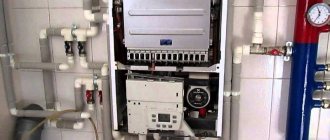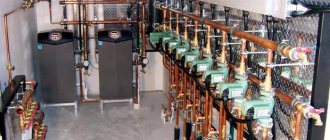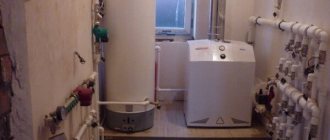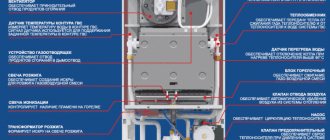For heating private homes and preparing hot water, double-circuit gas boilers are ideal. They work on the basis of transferring to the coolant the energy generated during the combustion of the most affordable and popular type of fuel. However, due to the extensive range of equipment, it can be difficult to choose. Do you agree?
We will tell you how to decide on the most suitable gas boiler model. The article we have proposed provides all the guidelines for choosing a unit with the highest possible efficiency that can withstand intense operating load. Market leading models and trusted manufacturers are listed.
Design features of the unit
A household gas appliance consists of a housing, two communication circuits, a built-in burner, a heat exchanger, an expansion tank, a combustion product exhaust unit, a gas valve and a control unit.
The main circuit is connected to the common heating system in a closed circuit. When the unit is actively operating in heating mode, the coolant circulates through the primary circuit pipes, but does not enter the hot water supply (DHW) communication system, since the path there is blocked by a special valve.
When installing equipment with two circuit elements, you must remember that the length of the communication pipe connecting the boiler to the farthest point of water intake should not exceed 7 meters. Otherwise, mineral elements deposited in the form of scale in the heat exchanger area will begin to interfere with the movement of the working fluid and the productivity of the water heater will significantly decrease
When the user turns on a hot tap in the kitchen or bathroom, the valve is activated, closes the entrance to the heating pipes and directs the coolant to the DHW circuit to warm up the water in the heat exchanger.
From there, the liquid enters the tap and is used for its intended purpose. When there is no longer a need for hot water and the tap is closed, a reverse switch occurs and the valve again redirects the coolant to the heating circuit.
What are wall-mounted double-circuit gas boilers?
Modern wall-hung double-circuit boilers have an excellent design, a minimum of communications around them and operate almost silently, so they can be installed in any room that meets the requirements.
Gas mounted double-circuit models with the same dimensions and heating technical characteristics combine the functionality of two devices at once - the boiler itself and a flow-through (less often storage) water heater. The coolant from the heating circuit in dual-circuit models does not mix with sanitary water from the hot water supply (DHW) circuit.
It is advisable to install wall-mounted double-circuit models in small and medium-sized residential buildings with an area of up to 350-400 m2, in which the distance from the boiler to the points of consumption is not too large (7-10 m). Otherwise, preparing and heating running water will take too much time, 20 seconds or more, which negatively affects not only comfort, but also water and fuel consumption.
Another important point is the number of people living in the house, or rather the number of points of simultaneous consumption of hot water. Most dual-circuit models operate on the principle of DHW priority, i.e. when the consumption point opens, the heating circuit is preheated. Less often, usually in more expensive models, where the distribution of performance is implemented using a three-way valve, the heating of the heating circuit does not stop completely, but the performance is still reduced.
In practice, this means that if you use several hot water consumption points at the same time, the performance of the DHW circuit may not be enough, not to mention the heating circuit. Therefore, the total number of rooms with hot water consumption points (bathroom, guest bathroom, kitchen, etc.) should not exceed three.
Design and principle of operation
A visual principle of operation of double-circuit boilers with priority for hot water supply (DHW).
Double-circuit wall-mounted boilers differ from single-circuit boilers only in the presence of an additional heat exchanger and devices for distributing productivity between the circuits. The technical device may vary from model to model, but the standard design is simple and clear: a burner to which gas is supplied and its igniters → a primary heat exchanger, inside of which there is a heating circuit coolant and a secondary heat exchanger, inside of which sanitary water from the DHW circuit circulates → product removal system combustion into the chimney.
All well-known and common models are already equipped from the factory with all the elements and components necessary for the heating system: expansion tank, circulation pump, automatic air vent, safety valve, pressure gauge, set of sensors, etc. This means that for a standard heating scheme it is enough to just connect the supply and return lines to the boiler, as well as a water source for the DHW circuit (for example, a water supply).
To clearly understand the operating principle of dual-circuit models, let’s consider the functionality of each circuit separately:
- heating - a basic circuit in which the coolant continuously circulates, heating up in the heat exchanger and releasing heat through radiators in heated rooms;
- water heating - activated only when the hot water consumption point is opened, redirects all or a certain part of the heating circuit coolant to water heating.
After closing the consumption tap, the boiler switches back to the heating circuit and heats it up if the coolant has cooled down, or goes into standby mode (background heating) if everything is fine with the temperature.
Traditional double-circuit boilers are always characterized by a delay in the supply of already heated water (from 5 to 15 seconds), but there are models without such a delay, with a built-in boiler, operating on the principle of a storage heater, which we will talk about when describing the selection criteria. In any case, there is also a delay in the supply of hot water, independent of the boiler, associated with the length of the pipeline between the boiler and the point of consumption, where the cooled water is located.
The device is based on the example of the famous dual-circuit BAXI ECO-4s 24F: compact classic layout, optimal materials, all modules are placed down for convenience.
How to choose a room thermostat and save up to 30% per month on heating
Classification by installation location
According to the installation principle, boilers serving two communication circuits are floor-mounted, wall-mounted and parapet-mounted. Each option has its own special characteristics.
Based on them, the client can choose the most suitable installation method for himself, in which the equipment will be conveniently located, will not “eat up” the usable area and will not cause problems during operation.
Floor-standing boilers
Floor-standing units are high-power devices that can heat and provide hot water not only to a standard apartment or residential building, but also to a large industrial premises, public building or structure.
If a double-circuit boiler is planned to be used not only for heating and supplying domestic hot water, but also for replenishing warm water floors, the basic unit is equipped with an additional circuit
Due to their large size and significant weight (up to 100 kg for some models), floor-standing gas boilers are not installed in the kitchen, but are placed in a separate room directly on the foundation or on the floor.
Features of wall equipment
A mounted appliance is a progressive type of household heating equipment. Due to its compact size, a geyser can be installed in the kitchen or other small rooms. It can be combined with any type of interior solution and fits organically into the overall design.
A double-circuit wall-hung boiler can be placed not only in the kitchen, but also in the pantry. It will take up minimal space and will not interfere with furniture or other household appliances
Despite its small size, a wall-mounted boiler has the same functionality as a floor-standing device, but has less power. It consists of a burner, an expansion tank, a pump for forced movement of the coolant, a pressure gauge and automatic sensors that make it possible to use the fuel resource with maximum efficiency.
All communication elements are “hidden” under a beautiful, modern case and do not spoil the appearance of the product.
The flow of gas to the burner is controlled by a built-in safety system. In the event of an unexpected interruption of the resource supply, the unit’s functioning completely stops. When fuel starts flowing again, the automation automatically activates the equipment and the boiler continues to operate in standard mode.
The automatic control unit allows you to set the device any operating parameters that are most suitable for the user. It is possible to set your own temperature conditions for different times of the day, thus ensuring economical consumption of fuel resources.
Nuances of parapet devices
A parapet boiler is a cross between a floor-mounted and a wall-mounted unit. It has a closed combustion chamber and does not create harmful emissions. Does not require the installation of an additional chimney. The combustion products are removed through a coaxial chimney laid in the outer wall.
A parapet-type boiler is the best option for heating equipment for small rooms with a weak ventilation system. The device is designed so that during operation it does not emit combustion products into the atmosphere of the room in which it is installed.
The device is mainly used to provide hot water and full heating to small houses and apartments in high-rise buildings where it is not possible to install a classic vertical chimney. The basic power ranges from 7 to 15 kW, but despite such low figures, the unit successfully copes with the assigned tasks.
The main advantage of parapet equipment is the ability to connect heating and water supply communications to the central gas system and pipelines from any side convenient for the user.
How to choose a wall-mounted double-circuit gas boiler for a private home
Convection or condensation
The operating principle of conventional convection (efficiency 88-92%) and condensing (efficiency 104-109%) gas boilers.
The first thing you need to decide is the type of boiler, which affects the principle of its operation and, accordingly, efficiency:
- convection - a traditional boiler that accumulates thermal energy exclusively from the combustion of gas in the combustion chamber, while some of the heat goes into the chimney along with the combustion products;
- condensing - a more advanced, efficient and expensive design with another additional heat exchanger that accumulates the heat of condensate formed from exhaust gases. The temperature of the exhaust gases with this operating principle is 30-50 degrees or more lower, and the thermal energy accumulated by the additional heat exchanger is directed to heating the return line.
Of course, in the second case, the efficiency of the installation is much higher; fuel savings, depending on the design, can reach 15-20%. The real element of condensing boilers is a low-temperature heating system (large radiators, constant burning at low power, coolant temperature up to 50°C), in which case the higher costs pay off after 3-5 years of operation. Otherwise, in modern Russian conditions, the payback period for condensing models is from 7 to 12 years.
The cost of condensing models starts from 50 thousand rubles, but more often it is 65 thousand rubles or more, with the exception of Korean and Chinese models costing about 30 thousand rubles. Such a high price is explained by the high requirements for the materials of the additional heat exchanger, which must be resistant to the acidic effects of condensate. Another disadvantage of condenser units is the need to dispose of condensate, which is not ordinary water. We have already described all the features in detail in the corresponding article.
All the differences and selection criteria for condensing gas boilers
If you do not plan to organize a low-temperature heating system, we do not recommend bothering with condensing models; today, for now, it is enough to choose a traditional convection boiler.
Structural design and material of the heat exchanger
Double-circuit boilers have two heat exchangers, which can be combined or separated:
- bithermal heat exchanger is a heating circuit and a domestic hot water circuit combined into one inseparable structure; they are combined according to a “pipe-in-pipe” scheme, in which sanitary hot water is located in the inner pipe, and the heating circuit coolant is in the gap between the walls of the inner and outer pipes
- monothermic heat exchangers are two separate traditional heat exchangers, in one (primary) the coolant of the heating circuit circulates, in the other - sanitary water of the DHW circuit.
Differences between boilers with one bithermic heat exchanger and two separate monothermic ones.
If in the case of a heating system, even the hardest, but not replaced water practically does not form scale that impedes circulation, although such cases do exist. Then in the DHW circuit the water is constantly changing, and when heated in the heat exchanger, it settles on the walls in the form of scale, significantly narrows the diameter of the coil, and over time completely clogs it.
But if two separate heat exchangers can be cleaned without problems even mechanically, then a bithermic (dual) heat exchanger is almost impossible to clean and if it becomes clogged with scale, it must be replaced. However, models with a single design are more compact and cheaper to manufacture than more reliable and durable boilers with two separate heat exchangers.
The bithermal heat exchanger cannot be cleaned mechanically and is quite difficult to rinse. When scale forms, it clogs faster.
No less important, affecting durability and reliability, is the material from which the heat exchanger is made:
- steel – steel heat exchangers are inexpensive to produce, lightweight and flexible, and are not afraid of sudden thermal changes, but they are highly susceptible to corrosion, even despite good anti-corrosion coatings. Their service life is usually 10-14 years;
- copper - copper heat exchangers are more expensive, but also more thermally conductive, more resistant to corrosion, their service life is about 14-17 years.
Availability of a storage tank
The photo shows Buderus Logamax plus GB172-24 with a built-in storage tank of 48 liters.
Modern mounted boilers can have various methods of preparing hot water:
- flow-through – the previously described principle in which water begins to heat up when the point of consumption is opened;
- storage – the principle in which a certain volume of heated hot water is constantly available in the built-in storage tank of the boiler.
If you use hot water intensively, we recommend choosing a boiler with a storage tank, the capacity of which can be from 30 to 60 liters. A storage tank means eliminating the 5-10 second delay in preparation, a certain supply of already heated water, and a more uniform temperature. Please note that formally such boilers are usually called “single-circuit boilers with a built-in boiler”; when searching in the product catalog of an online store, they may be located in this category.
Combustion chamber design and types of smoke removal
According to the method of supplying the oxygen necessary to maintain combustion and removing combustion products, all double-circuit gas boilers can be:
- with an open combustion chamber (atmospheric boilers) - combustion air is taken from the room through openings in the housing, and combustion products are discharged through a traditional vertical chimney;
- with a closed combustion chamber (turbocharged boilers ) - air for fuel combustion is taken from the street, through a coaxial chimney, and with the help of it the combustion products are removed.
The type of combustion chamber determines the cost and ease of installation, the cost of the boiler itself, as well as the requirements for the room for its installation.
Open combustion chamber and natural draft
Atmospheric boilers are cheaper, but often have slightly lower technical characteristics. Combustion products are discharged through a traditional vertical chimney using natural draft. To ensure this, a pipe with a diameter of 120 mm and a length of 4-5 m is required; detailed requirements are usually specified in the boiler documentation.
In addition to more complex installation, the disadvantage of atmospheric models is their faster contamination and the need for periodic cleaning of the burner, ignition electrodes, etc. It is also not recommended to install them in residential premises (in corridors, kitchens, etc.), since they take oxygen for combustion from the same room; when placed in a boiler room, proper ventilation must be ensured.
Closed combustion chamber and forced draft through a coaxial chimney
Boilers with a closed combustion chamber are equipped with a forced-air fan (turbine), which forcibly removes combustion products and helps draw fresh air into the combustion chamber. The efficiency and economy of turbocharged boilers is higher, due to the fact that the turbine rotation speed is automatically adjusted; the boiler always maintains optimal combustion due to the optimal ratio of fuel and oxygen.
A serious advantage of boilers with a closed combustion chamber is the absence of the need to organize a full-fledged traditional chimney. Air is taken in and gases are removed through a coaxial (side) chimney, in which the inner pipe serves to remove combustion products, and the gap between the inner and outer pipes serves to take in fresh air. The coaxial chimney comes complete with the boiler and is mounted very simply into a hole in the wall.
But even in this case there are disadvantages:
- When operating at high speeds, the turbine creates a certain noise, in some models it is quite noticeable, and in others it operates almost silently;
- a coaxial chimney can negatively affect the aesthetic appearance of the house;
- turbocharged boilers consume 20-50 W more electricity.
- in cost they are 3-5 thousand rubles more expensive.
We recommend choosing models with a closed combustion chamber: they are more efficient and safe, easier to install, and do not require ventilation.
All necessary communications (piping) of a mounted double-circuit model with a closed combustion chamber.
DHW performance
Almost all modern double-circuit wall-mounted boilers produce about 8-12 l/min of hot water, regardless of their power. This volume is absolutely enough for two points of consumption, open to the maximum, so focusing on the DHW performance indicator should be done at one of the last stages and paying attention only to serious deviations from the average values.
But in order to roughly imagine how much boiler performance is sufficient, you can calculate the maximum consumption.
For example, the throughput of an average mixer in a bathroom or kitchen is in the range of 3-5 l/min; of course, the value depends on the diameter of the pipe, pressure and efficiency of the mixer (ratio of air and water at the outlet).
Efficiency
The efficiency factor (efficiency) is the ratio of the volume of fuel consumed to the volume of heat generated, that is, the efficiency of the boiler. The optimal indicator for a modern mounted boiler is 89-92%. However, you should also pay attention to efficiency last, having decided on the previous parameters, since a difference of 1, 2 and even 3% will be expressed not in hundreds, but in tens of rubles per month.
It is worth paying attention only to indicators below 86%; in 2022 these are unacceptable indicators for a good mounted gas boiler, indicating technical imperfection, and the difference in operating costs compared to models with an efficiency of 90% and above will be noticeable.
How to replace a gas boiler in a private house without violating the law
Minimum required power
It is reasonable to select the power after deciding on the model, since all modern models have a wide selection of versions with different heating capacities (usually the range is from 12 to 35 kW and wider).
For an average uninsulated or poorly insulated house in the climatic zone of the Moscow region, with 2 bricks and a ceiling height of 2.7 m, the minimum required power of heating equipment is calculated based on the rule: 1 kW for every 10 m2 of heated area. We also recommend setting aside a power reserve of 15-20%, and in the case of a double-circuit boiler - 25-30%.
For example, for the above-described house with an area of 150 m2, the minimum required power is 150/10 * 1.3 (30% reserve) = 19.5, that is, 20 kW.
In non-standard cases, if panoramic windows are used and the glazing area is much larger, the ceilings are high, the house is well insulated, and is located in the extreme southern or northern point of the country, correction factors are taken into account that can change the result by 15-30% up or down. You can make a detailed calculation using the calculator below.
In conclusion, it is worth mentioning the criteria that increase the comfort of operation, but, accordingly, the price of the boiler:
- the presence of a sound insulation layer that seriously reduces the noise level of the boiler;
- the presence of a programmer that allows you to set the boiler operating pattern for a day or a week;
- the ability to send fault notifications via SMS, using a GSM module, as well as control via Wi-Fi.
Model differences in power
Double-circuit boilers are divided by power into single-stage and two-stage. Single-stage devices always operate at a constant power level and use the same amount of fuel resource year-round.
This is not effective and entails excessive gas consumption, because a house or apartment requires high-quality heating for no more than 5 months a year. At all other times, running the equipment at full power is neither reasonable nor economically profitable.
When installing equipment with a base power of 30 kW, you should know that these types of devices should not be located in residential premises, but in separate rooms equipped with a high-quality ventilation system, individual access to the street and a full-fledged chimney
The functionality of two-stage devices is wider.
With it you can:
- regulate the gas flow regime and rationally consume fuel;
- reduce the number of on/off switches, thus reducing equipment wear and extending its service life;
- reduce the volume of harmful emissions into the air to a minimum.
Additionally, the device is equipped with a smooth switching module, which reduces energy consumption and allows you to simultaneously operate a boiler and a boiler of any capacity, installed separately.
Kinds
Double-circuit gas boilers are distinguished according to certain characteristics.
By installation method:
- Wall mounted . For hanging installation, strong load-bearing walls are required. The dimensions and weight of such units are limited by permissible load conditions.
- Floor-standing . They can be installed directly on the floor, which expands the capabilities of boilers and allows them to be equipped with massive units of increased power and productivity.
By type of heat transfer:
- Convection . The coolant is heated by a gas burner.
- Condensation . A two-stage heating scheme is used, where the first stage is the heating of the return flow in the condensation chamber, and the second is the usual preparation process in the primary heat exchanger. For the process to proceed correctly, it is necessary to provide appropriate conditions, which is only possible in the southern regions.
By heat exchanger type:
- Separate . The heating of the coolant is carried out by the primary unit, and the secondary heat exchanger (usually plate type) is responsible for preparing hot water.
- Combined (bithermic) . It is a coil made of a pipe of a specific cross-section, where two streams can flow simultaneously without mixing. Allows you to increase DHW productivity, but is difficult to clean from lime deposits.
By type of combustion chamber:
- Atmospheric (open) . The traditional way of boiler operation, where smoke is removed naturally through a standard chimney, and air is taken directly from the room.
- Turbocharged (closed) . Air is taken from the outside using a coaxial chimney (pipe-in-pipe design). The turbocharger fan provides fresh flow. It also displaces flue gases, providing a stable and adjustable smoke removal mode.
IMPORTANT!
Turbocharged models are much more efficient and stable in operation; they are optimally suited for use in residential areas.
Types of working gas burners
A gas burner can be atmospheric or pressurized. The first type has a simple design and does not produce any noise during operation. The module is cheap and, as a rule, is included in the basic package of the boiler.
Despite its simplicity, the atmospheric burner is very reliable and works well for a long time. Can be used both on budget devices and on expensive, “sophisticated” luxury products
The operating principle of an atmospheric burner is reminiscent of the operation of industrial hearth models. The fuel resource is supplied through an ejector and, due to draft, absorbs air from the surrounding atmosphere. Through a special hole, the mixture enters the combustion chamber and immediately ignites.
As a result, fiery tongues of flame with a very low actual temperature appear above the outlet holes, the task of which is to heat the coolant to the required level.
Pressurized (mounted) burners demonstrate a high level of efficiency, constantly maintaining the set temperature both in the coolant itself and in the hot water supply system, but they are much more expensive than their atmospheric counterparts.
However, these costs are justified, since the modules have expanded functionality and make it possible to use fuel resources as wisely as possible, without reducing the level of comfort of the home.
A pressurized (mounted) type burner is not included in the basic set of a double-circuit gas boiler. It is purchased separately and then installed on heating equipment
During full operation in pressurized burners, the air supply is forced, and its volume is very clearly controlled by internal automation. The module is installed in devices equipped with a closed combustion chamber operating with supercharging.
Fuel and air are mixed not inside the system, but at the outlet. The operating process of the device is almost completely automated and does not require human control.
Atmospheric burners are installed in dual-circuit heating devices with a power of up to 80 kW. Supercharged (mounted) modules are being implemented into large-sized units with a capacity of up to several thousand.
The best condensing dual-circuit models 2022
Protherm Lynx 25/30 MKV
The Slovak-made condensing model is capable of heating up to 212 m2 and produces approximately 14.2 liters of hot water per minute. This performance is quite enough to provide two water points - for example, a kitchen and a bathroom. There is a turbocharged closed combustion chamber here, so there will always be enough oxygen in the house (more precisely, the boiler will not burn it). Like the Ariston model, Lynx is equipped with a “hot start” function, which speeds up the heating of water in the water supply system. There is also a sensor installed here that switches the device to summer mode during the warm season. In this mode, the unit only works to heat water.
The efficiency of the device, thanks to the receipt of thermal energy from steam, is 104%, which is approximately 9% more than that of conventional convection models. The manufacturer has equipped the model with protection systems against freezing and water overheating. The first controls the temperature of the water in the heating pipes and, when it drops below 5° C, starts the boiler to avoid the formation of ice. The second turns off the device when the critical water temperature is reached. Overall, this is an excellent boiler for the money, which works one hundred percent.
BAXI Duo-Tec Compact 28
This unit is designed for a large house up to 224 m2. Its efficiency is slightly higher than the previous one and is 105.8%, which, compared to conventional convection ones, gives about 11% savings on gas. The second circuit is capable of heating up to 16.1 l/min of water, which is enough to operate a shower stall, washbasin and sink. A turbocharged combustion chamber and a forced smoke exhaust system will help maintain a comfortable atmosphere in the apartment. Both heat exchangers are made of stainless steel. Please note that the boiler design is equipped with an outside temperature sensor. It monitors the temperature outside the window and, in accordance with it, reduces or increases the power of the unit.
You can safely connect a heated floor to the device, since there is a powerful circulation pump. It allows you to effectively pump water through a circuit with high resistance. If the water circulation is disrupted, the device turns off the gas supply to the burner, as well as the pump itself, to avoid damage to these components. There are also systems installed here to protect against freezing and overheating of water in the pipes.
Bosch Condens GC7000iW
This model in the Bosch line of condensing boilers is one of the most economical. It can operate on both natural and liquefied gas. Its efficiency is as much as 108% - this is 13 - 15% better than convection devices. When you connect the Easy Control control panel, you can control the device via the Internet. This is very convenient, since you can receive a report on the operation of the boiler or generated errors even while at work. The unit can work with both water and antifreeze specified in the passport documentation for the device.
The design of the device is equipped with a 5th generation aluminosilicate heat exchanger with a matrix burner. There is also a 12 liter expansion tank. The maximum productivity of hot water at a temperature of 30 ° C is about 12 l/min - this is enough for two water points. A pressure gauge is installed on the front panel to visually determine the operating pressure. This is a high-quality, durable German-made boiler for heating and hot water supply. But as you know, you have to pay for quality, and this truth is confirmed by the rather high price of this unit.
Some more useful tips for organizing heating in your home:
Voltage stabilizer for a gas boiler: which one to buy for your home?
Heating cables for water supply: which one is better?
Types of ignition function
A household double-circuit boiler is started manually (using matches or a lighter) or using built-in elements (electric ignition or piezo ignition). The first method is the simplest and most accessible. The second makes it possible to save blue fuel by not leaving the wick in the igniter to burn constantly.
There is only one disadvantage of this option - dependence on the availability of electricity in the network. If for some reason the power stops flowing, the equipment immediately turns off and is automatically activated again when the electrical supply is restored.
Piezo ignition is absolutely safe and allows you to turn on the boiler by pressing just one button. The element does not depend on the supply of current and you can use the equipment even in the absence of electricity.
Condensing and traditional boilers
A heating solution based on a condensing double-circuit boiler is more technologically advanced and somewhat more expensive. The idea of condensing devices is to provide additional energy output in the form of heat recovery from flue gases.
The immediate effect, after which the efficiency of the system can be observed, is a lower temperature of the exhaust gases at the chimney outlet. The effectiveness of this solution often exceeds 100%.
A double-circuit condensing boiler is not a perpetual motion machine. This value is due to the fact that it is calculated in relation to the output without recovering part of the flue gas energy. By choosing this selection criterion, you can truly achieve more than 100% success. It is condensation that allows you to obtain additional heat.
Equipment traction options
During operation of the unit, fuel burns and flue gases are generated. To remove them from a living space, natural or forced draft is necessary. It will ensure timely removal of all combustion products and released harmful substances from the apartment or house.
Natural draft modules
Boilers operating on natural draft have a simple design and take the air necessary for proper combustion from the room in which they are located. During intensive use, a certain amount of steam and various chemicals are released. Emissions are removed through a vertical chimney.
Among the main advantages of units with natural draft are reasonable cost, energy independence and absence of noise effects during operation.
In general, devices with natural draft are convenient and good, however, when the pressure in the gas pipeline drops, the quality of their work decreases significantly. At the same time, the risk of rapid burnout of the burner increases, since the fire at a reduced pressure level dies out or goes inside the burner device.
Uneven pressure in the main networks provokes serious overconsumption of fuel, which entails an increase in the amount of utility bills.
Forced draft devices
Boilers with forced draft are sometimes called forced-air or fan-type. They take air not from the room where they are located, but from the street. The modules have closed combustion chambers, and waste substances are emitted through a coaxial horizontal outlet using a powerful fan built into the system.
A coaxial bend consists of two pipe elements of different diameters inserted into one another. Through the smaller pipe, combustion products exit the room, and through the space between the small and large pipes, fresh air enters the room from the street, which is necessary for the full functioning of the boiler
Products with forced draft are easy to install, do not make any demands on the location, do not “eat up” oxygen in residential premises, work stably and accurately even with reduced gas pressure in the central main networks and do not require the installation of an additional vertical chimney.
The devices are criticized for the noisy operation of fan elements, higher cost and dependence on power supply.
Structural characteristics
The heating device consists of two heat exchangers (for heating and hot water), temperature control and burner. This structure ensures high-quality and reliable operation of the equipment and ease of operation.
Thanks to two circuits, the system provides the entire house with heating and constant hot water. For safety reasons, the heating boiler shuts off the gas supply if there is no flame.
Types of boilers
Wall-mounted double-circuit heating boilers can be found in two types:
- bithermic;
- duothermal.
The first type is a structure of two steel tubes located one inside the other. The internal circuit provides hot water supply, the external circuit provides heating. This system is very effective. Duothermic boilers consist of two heat exchange circuits. Each tank has a durable copper tube, which, when heated, releases heat to both systems (DHW and heating). Then heat consumption is minimized.
Power
When choosing a heating device, special attention should be paid to power indicators. Traditionally, the rate can be calculated using the formula: 1 kW x 10 m2. A double-circuit boiler must have a power of at least 24 kW. This will provide comfortable conditions at any time of the year.
There is no need to worry about excessive fuel consumption if the apartment area is less than 240 m2: the device uses exactly the required amount of gas to heat the room.
Tank volume and burner type
The average volume of the water tank is from 30 to 60 liters. If the water consumption is much higher (relevant for a private home), you need to install an additional boiler. A standard boiler provides up to 15 liters of hot water at a temperature of 35C°. The design is designed in such a way that even in the cold season the temperature will be adjusted to maximum comfort.
In modern heating equipment, two types of burners are used: open and forced. The first option is the most economical, since it consumes the minimum amount of energy.
Heat exchanger and gas flow
The main criterion when choosing a heat exchanger is the material. The most common metal is cast iron. It is characterized by durability (with proper use) and high thermal conductivity. The heavy weight of the metal and fragility are the main disadvantages of the heating device. Steel heat exchangers are lighter, more reliable, and when chrome-plated they are also resistant to corrosion.
Gas consumption is related to the boiler power. The greater the power, the higher the need for fuel, which means the device will consume more gas.
Distinctive features of heat exchangers
The heat exchange unit of the heating device can be cast iron, steel or copper. The cast iron version retains heat for a long time, is almost not subject to corrosion due to the high wall thickness and is resistant to aggressive coolants. It is heavy and therefore mainly integrated into floor-standing boilers.
Requires great care during installation, since any impacts violate the structural integrity of the material and lead to the formation of microcracks.
The steel structure weighs little, is not afraid of mechanical stress, can easily withstand temperature changes in the coolant, and is easily transported and installed. Has some tendency to corrosion. The boiler control system helps to avoid it, which prevents the coolant temperature from falling below the critical point.
Copper elements are an order of magnitude more expensive than their cast iron and steel counterparts, but they compensate for the substantial cost with a large number of advantages. Inside the copper heat exchanger, sediment and scale are formed to a minimum and do not interfere with the normal circulation of the working fluid. The walls of the device are heated evenly and do not cause local overheating of the coolant.
Advantages and disadvantages of gas systems
In places where central gas communications are laid, double-circuit boilers are very popular. They are purchased for heating and uninterrupted supply of hot water to apartments, residential buildings and country cottages.
The main advantages of the devices
The gas system demonstrates a high level of efficiency, delivers several times more energy than it consumes, lasts a long time and operates smoothly. Does not require constant human supervision.
The double-circuit boiler looks neat and modern. Unlike units operating on solid or liquid fuels, during operation it practically does not emit unpleasant odors and creates a minimum of soot and soot
The fuel resource is supplied to the installation continuously, and the built-in controller independently monitors the presence of fire on the burner. If the flame dies out, the sensor sends a signal to the ignition unit and the automatic supply of a spark instantly restores the fire. Controlling the boiler is simple and does not present any difficulty.
Disadvantages of dual-circuit equipment
The main disadvantages are associated not so much with the device itself, but with the process of its legalization and installation. You can’t just buy a boiler, bring it home and install it yourself according to the connection diagram. First, you will have to comply with a lot of technical nuances, draw up documentation and coordinate all subsequent actions with the local gas supply company.
There you will need to provide:
- equipment installation project, drawn up in accordance with the norms adopted by law;
- installation agreement with a specialized organization;
- a copy of the license of the specialized organization confirming the right to carry out work.
In addition, you will need to organize the removal of exhaust gas from the living space, lay an additional chimney for this or use an existing old one, and install additional equipment to control potential gas leaks.
If the boiler smokes, perhaps the pressure in the system has decreased or the existing burner has worn out and begun to burn out. A specialist with relevant experience will help you quickly fix problems
The main installation activities can begin only when the project documentation for the organization of gas heating has passed all stages of approval and the client receives a stamped permit for the installation of the system.
Pump for double-circuit boiler
A circulation pump in a heating system with a double-circuit boiler is a solution for people who want quick access to hot water and ensure uniform heating, for example, of underfloor heating systems and radiators.
The idea of this solution is to ensure continuous movement of water inside the installation.
- In this case, the biggest disadvantage is higher financial costs.
- From a technical point of view, it is necessary not only to use the pump itself, but also to lay additional pipes to the farthest taps.
- The pump itself does not have to be very large, so it does not consume a significant amount of electricity.
Review of popular manufacturers and models
The market for modern gas equipment offers customers a large number of high-quality appliances designed for heating residential premises and supplying hot water.
Among the mounted units, the most popular are:
- Navien DELUXE 24K (South Korea) - efficiency, good functionality and reasonable cost;
- Baxi MAIN 5 24 F (Italy) – budget price, high level of efficiency, long service life;
- Vaillant turboTEC pro VUW 242/5-3 (Germany) – reliability, high-quality heat transfer.
In addition to the above qualities, the models are distinguished by their attractive appearance, compact dimensions, fit into a variety of interiors and can be easily placed even in small rooms with complex layouts.
A gas appliance with two circuits from the German company Vaillant has a convenient control knob and a display on which you can see the level of heating of the coolant at the moment
Of the floor-standing units, the most popular are the high-power (30 kW) ATON Atmo 30E, the practical Lemax Premium-25B and the more expensive, but very functional Navien GA 17KN.
Navien GA 35KN, despite its high power, uses fuel reasonably and allows owners to save on utility bills without compromising personal comfort
Baxi SLIM 2.300 Fi and Protherm Bear 40 KLZ are part of the premium line of equipment. They have advanced functionality and reliably serve for many years. In all parameters and physical characteristics they comply with the most stringent European standards (confirmed by certification certificate CSQ and UNI EN ISO 9001).
For a small room (up to 50 sq.m.), a boiler with a base power of 7 to 12 kW is suitable. If the real estate area is larger (for example, 150-200 sq.m.), it is better to purchase a 23-25 kilowatt device
Weak units simply cannot provide full heating to an apartment or large house.
You should buy floor-standing gas boilers and wall-mounted models only in branded stores or official representative offices of manufacturing companies. There, the client will be told in detail about the operating principles of this or that unit and will be helped to make the optimal choice.
What parameters should you pay attention to when purchasing?
When choosing a suitable model of a gas double-circuit boiler, you should pay attention to the main technical parameters of the units:
Combustion chamber type
The most popular are boilers with a closed combustion chamber. The entire process of fuel combustion and smoke removal occurs in a system isolated from the room atmosphere, which increases safety for people.
In addition, the controlled smoke removal process is much more effective than unstable natural draft.
Power
The boiler power level is the main indicator demonstrating the ability of the unit to provide thermal energy to rooms of different sizes.
Usually the desired model is selected based on 1 kW of power per 10 m2 of area.
It is necessary to take into account that you should not make a large reserve, since the boiler operating mode should be close to the nominal one.
Heat exchanger material
For the manufacture of heat exchangers they use:
- Stainless steel . This is the most affordable option, which is used in boilers in the middle and budget price range. The heat transfer and service life of such units are quite high, there is the possibility of repair or restoration.
- Copper . Heat exchangers of this type are installed in the most expensive and productive series of gas boilers. The performance of copper heat exchangers is considered the highest.
- Cast iron . Typically used in powerful floor-standing units. The heating mode is stabilized due to the high thermal inertia of the material.
Boiler type
There are two types:
- Convection . Conventional design of a gas unit.
- Condensation . In addition to the traditional method, these models are equipped with a coolant preheating function, which reduces fuel consumption and the load on the heat exchanger.
When choosing the type of boiler, it is necessary to take into account that the operation of condensing devices is possible only when the difference between external and internal temperatures is no more than 21°, which in Russia cannot be ensured due to climatic conditions.
Energy independence
There are volatile and independent installations. The former have the maximum range of functions, but in the event of a sudden power outage they become useless.
The latter do not use electricity, which expands the geography of their use. At the same time, non-volatile models have minimal capabilities and a complex ignition method.











